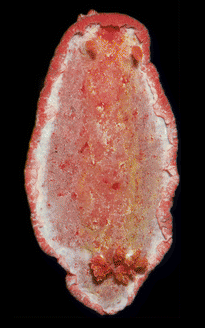Hexabranchus morsomus
Hexabranchus morsomus, also known as the "Caribbean Spanish Dancer",[3] is a species of sea slug, a marine mollusc in the family Hexabranchidae.[4][2]
| Hexabranchus morsomus | |
|---|---|
 | |
| dorsal view of Hexabranchus morsomus | |
| Scientific classification | |
| Kingdom: | |
| Phylum: | |
| Class: | |
| (unranked): | clade Heterobranchia clade Euthyneura clade Nudipleura clade Nudibranchia clade Euctenidiacea clade Doridacea |
| Superfamily: | |
| Family: | |
| Genus: | |
| Species: | H. morsomus |
| Binomial name | |
| Hexabranchus morsomus Ev. Marcus & Er. Marcus, 1962[1] | |
| Synonyms[2] | |
|
Caribranchus morsomus (Ev. Marcus & Er. Marcus, 1962) | |
Distribution
It occurs in the Caribbean Sea including waters around St. Kitts and the Netherlands Antilles,[5] and has also been identified in Honduras, Panama, Costa Rica, Venezuela, St. Lucia, Martinique, Antigua, Grenada, St. Vincent & the Grenadines, Trinidad & Tobago,[3] Aruba, Puerto Rico, Virgin Islands, Sint Maarten.[6]
Description
Body is oval to elongate.[6] Dorsum is small with conical tubercles.[6] Rhinophores are club shaped.[6] Gill is large, composed of several multi-pinnated leaves.[6] Background color is reddish with mottled white and yellow patches on the dorsum.[6] Mantle margin usually curled up over small portion of dorsum covering white areas.[6] It is up to 400 mm long.[6]
Ecology
It is found under rocks or coral rubble, primarily on living reefs.[6] Minimum recorded depth is 0 m.[7] Maximum recorded depth is 33 m.[7] Defensive behavior consists of the unrolling of the mantle margins to expose bright white areas followed by swimming by contracting the body and mantle margin.[6] Species of the genus Hexabranchus prey on a variety of sponges.[6]
Further reading
- Valdés Á. (2002) "How many species of Hexabranchus (Opisthobranchia : Dorididae) are there?" Molluscan Research 22(3): 289-301. PDF.
References
This article incorporates Creative Commons (CC-BY-4.0) text from the reference[6]
- Ev. Marcus & Er. Marcus (1962). "Opisthobranchs from Florida and the Virgin Islands". Bulletin of Marine Science of the Gulf and Caribbean. 12 (3): 450–488.
- Gofas, S. (2013). Hexabranchus morsomus Ev. Marcus & Er. Marcus, 1962. Accessed through: World Register of Marine Species at http://www.marinespecies.org/aphia.php?p=taxdetails&id=549228 on 2014-01-01
- Valdés, Ángel; Hamann, Jeff; Behrens, David W.; DuPont, Anne. Caribbean Sea Slugs, Sea Challengers Natural History Books, Etc., Gig Harbor, Washington 2006, pp. 116-117. ISBN 0-9700574-2-3
- PNAS, Nudibranch Taxonomy, accessed 1 January 2014.
- Rudman W. B. (2002, September 8) "Hexabranchus morsomus Marcus, 1962". Sea Slug Forum. Australian Museum, Sydney, accessed 22 October 2016.
- Goodheart J. A., Ellingson R. A., Vital X. G., Galvão Filho H. C., McCarthy J. B., Medrano S. M., Bhave V. J., García-Méndez K., Jiménez L. M., López G. & Hoover C. A. (2016). "Identification guide to the heterobranch sea slugs (Mollusca: Gastropoda) from Bocas del Toro, Panama". Marine Biodiversity Records 9(1), p.56. doi:10.1186/s41200-016-0048-z
- Welch J. J. (2010). "The “Island Rule” and Deep-Sea Gastropods: Re-Examining the Evidence". PLoS ONE 5(1): e8776. doi:10.1371/journal.pone.0008776.